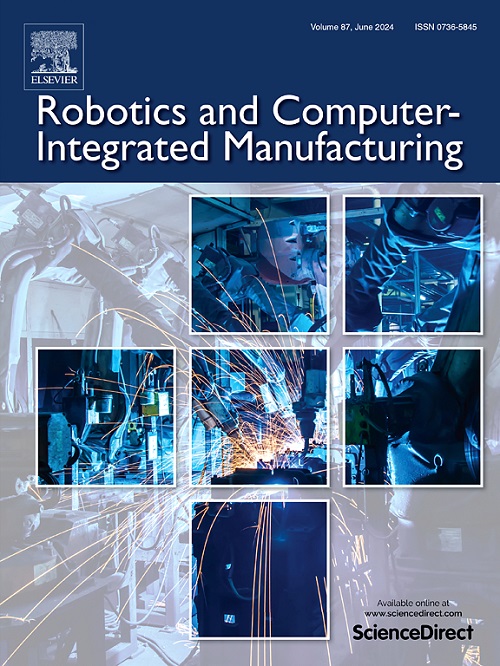并联电磁变刚度机器人柔顺磨削机械手的设计与控制
IF 11.4
1区 计算机科学
Q1 COMPUTER SCIENCE, INTERDISCIPLINARY APPLICATIONS
引用次数: 0
摘要
环境适应性是机器人操作的关键问题,而并联机器人有限的顺应性制约了其在变刚度环境中的应用。提出了一种新型的三自由度并联电磁变刚度机械臂(PEVSM),该机械臂通过自刚度调制来主动适应环境。PEVSM集成了一个由电磁弹簧驱动的无约束可变刚度分支和三个由洛伦兹电机驱动的柔性分支,可以实现主动和连续的刚度调制。在建立的运动学和刚度模型的基础上,建立了一种力-位置-刚度混合控制框架,将增强型分数阶自适应阻抗控制与基于多源反馈的深度确定性策略梯度刚度控制器相结合,实现了力的精确、柔性调节。为了将机器人磨削应用于低刚度工件,提出了一种力-变形模型和力补偿策略,以减轻变形影响,提高材料去除精度。构建了基于PEVSM的机器人磨削平台,证明了其在柔性磨削中提高力控制和材料去除精度方面的优势。本文章由计算机程序翻译,如有差异,请以英文原文为准。
Design and control of a parallel electromagnetic variable stiffness manipulator for robotic compliant grinding
Environmental adaptability is a key challenge in robotic operation, while the limited compliance of parallel manipulators hinders their application in variable-stiffness environments. This paper proposes a novel three-degree-of-freedom parallel electromagnetic variable stiffness manipulator (PEVSM) that actively adapts to the environment through self-stiffness modulation. PEVSM integrates an unconstrained variable stiffness limb driven by an electromagnetic spring and three compliant limbs actuated by Lorentz motors, enabling active and continuous stiffness modulation. Based on the established kinematic and stiffness models, a hybrid force-position-stiffness control framework is developed, integrating enhanced fractional-order adaptive impedance control and a stiffness controller based on deep deterministic policy gradient with multi-source feedback to achieve precise and compliant force regulation. For applying robotic grinding to low-stiffness workpieces, a force–deformation model and a force compensation strategy are introduced to mitigate deformation effects and improve material removal accuracy. The robotic grinding platform with PEVSM is constructed, demonstrating its advantages on improve force control and material removal accuracy in compliant grinding.
求助全文
通过发布文献求助,成功后即可免费获取论文全文。
去求助
来源期刊
CiteScore
24.10
自引率
13.50%
发文量
160
审稿时长
50 days
期刊介绍:
The journal, Robotics and Computer-Integrated Manufacturing, focuses on sharing research applications that contribute to the development of new or enhanced robotics, manufacturing technologies, and innovative manufacturing strategies that are relevant to industry. Papers that combine theory and experimental validation are preferred, while review papers on current robotics and manufacturing issues are also considered. However, papers on traditional machining processes, modeling and simulation, supply chain management, and resource optimization are generally not within the scope of the journal, as there are more appropriate journals for these topics. Similarly, papers that are overly theoretical or mathematical will be directed to other suitable journals. The journal welcomes original papers in areas such as industrial robotics, human-robot collaboration in manufacturing, cloud-based manufacturing, cyber-physical production systems, big data analytics in manufacturing, smart mechatronics, machine learning, adaptive and sustainable manufacturing, and other fields involving unique manufacturing technologies.

 求助内容:
求助内容: 应助结果提醒方式:
应助结果提醒方式:


